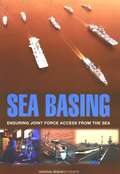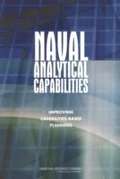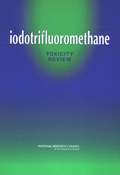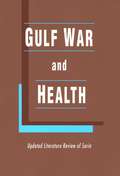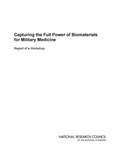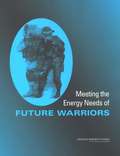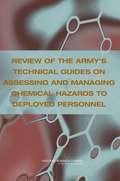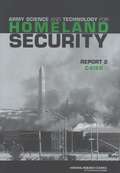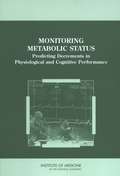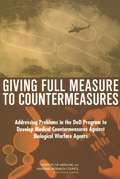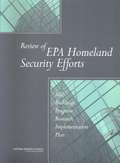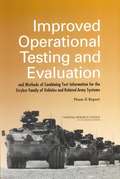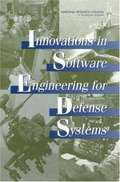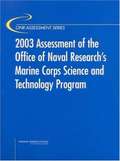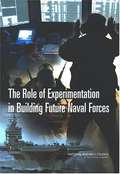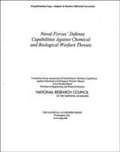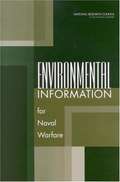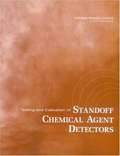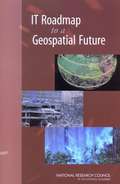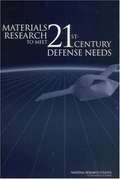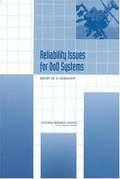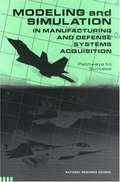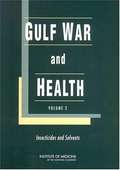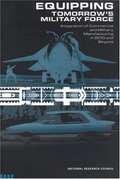- Table View
- List View
Sea Basing: Ensuring Joint Force Access From The Sea
by National Research Council of the National AcademiesThe availability of land bases from which to launch and maintain military, diplomatic, and humanitarian relief operations is becoming increasingly uncertain because of physical or political constraints. The ability to operate from a sea base, therefore, is likely to become more and more important. The Defense Science Board recently concluded that Sea Basing will be a critical future joint military capability and that DOD should proceed to develop such capability. Following the DSB report, the Navy requested that the National Research Council (NRC) convene a workshop to assess the science and technology base, both inside and outside the Navy, for developing Sea Basing and to identify R&D for supporting future concepts. This report of the workshop includes an examination of Sea Basing operational concepts; ship and aircraft technology available to make Sea Basing work; and issues involved in creating the sea base as a joint system of systems.
Naval Analytical Capabilities: Improving Capabilities-based Planning
by National Research Council of the National AcademiesThe National Academies Press (NAP)--publisher for the National Academies--publishes more than 200 books a year offering the most authoritative views, definitive information, and groundbreaking recommendations on a wide range of topics in science, engineering, and health. Our books are unique in that they are authored by the nation's leading experts in every scientific field.
Iodotrifluoromethane: Toxicity Review
by Subcommittee on IodotrifluoromethaneThe U.S. military is considering using a compound called iodotrifluoromethane (CF3I) for fire suppression to replace previously-used compounds (halons) that are being phased out because they deplete the ozone layer. This report reviews available toxicological data on CF3I and evaluates the scientific basis of the U.S. Army's proposed exposure limit of 2,000 parts per million (ppm). The report recommends that CF3I be used for fire suppression in normally unoccupied spaces because of its potential to cause cardiac sensitization in test animals. The report also recommends that further genotoxicity testing be conducted (testing for changes in genetic material), and that CF3I be assessed for its potential to cause cancer. Should the Army decide to use CF3I, information should be collected and evaluated on how much of the chemical or any of its degradation products might be released and how often.
Gulf War and Health: Updated Literature Review of Sarin
by Committee on Gulf WarThe Gulf War in 1990-1991 was considered a brief and successful military operation, with few injuries or deaths of US troops. The war began in August 1990, and the last US ground troops returned home by June 1991. Although most Gulf War veterans resumed their normal activities, many soon began reporting a variety of nonexplained health problems that they attributed to their participation in the Gulf War, including chronic fatigue, muscle and joint pain, loss of concentration, forgetfulness, headache, and rash. Because of concerns about the veterans' health problems, the Department of Veterans Affairs (VA) requested that the Institute of Medicine (IOM) review the scientific and medical literature on the long-term adverse health effects of agents to which the Gulf War veterans may have been exposed. This report is a broad overview of the toxicology of sarin and cyclosarin. It assesses the biologic plausibility with respect to the compounds in question and health effects.
Capturing the Full Power of Biomaterials for Military Medicine: Report of a Workshop
by Committee on Capturing the Full Power of Biomaterials for Military Medical NeedsRecent results in biomaterials R&D suggest that there are exceptional opportunities for these emerging materials in military medicine. To facilitate this possibility, the National Research Council convened a workshop at the request of the Department of Defense to help create a technology development roadmap to enhance military R&D into biomaterials technology. The workshop focused primarily on identifying useful near- and mid-term applications of biomaterials including wound care, tissue engineering, drug delivery, and physiological sensors and diagnostics. This report presents a summary of the workshop. It provides a review of biomaterials and their importance to military medicine, the roadmap, and a discussion of ways to enable biomaterials development. Several important outcomes of successful capture of potential benefits of these materials are also discussed.
Meeting the Energy Needs of Future Warriors
by Committee on Soldier Power/Energy SystemsThe central characteristic of the evolution of the combat soldier in recent years is an increasingly sophisticated array of sensing, communications, and related electronics for use in battlefield situations. The most critical factor for maintaining this evolution will be the development of power supply systems capable of operating those electronics effectively for missions up to 72 hours long. To address the challenge, it is important that new approaches be sought on how to integrate and power these electronics. To assist in addressing this problem, the Army requested the National Research Council to review the state of the art and to recommend technologies that will support the rapid development of effective power systems for the future warrior. This report presents the results of that review. It provides an assessment of various technology options for different power level requirements, power system design, and soldier energy sinks. The report also describes future design concepts, focusing on low-power systems. Recommendations for technology development and system design are presented.
Review Of The Army's Technical Guides On Assessing And Managing Chemical Hazards To Deployed Personnel
by Subcommittee on the Toxicological Risks to Deployed Military PersonnelTo guide mission planning, military decision makers need information on the health risks of potential exposures to individual soldiers and their potential impact on mission operations. To help with the assessment of chemical hazards, the U.S. Army Center for Health Promotion and Preventive Medicine developed three technical guides for characterizing chemicals in terms of their risks to the mission and to the health of the force. The report reviews these guides for their scientific validity and conformance with current risk-assessment practices. The report finds that the military exposure guidelines are appropriate (with some modification) for providing force health protection, but that for assessing mission risk, a new set of exposure guidelines is needed that predict concentrations at which health effects would degrade the performance of enough soldiers to hinder mission accomplishment.
Army Science And Technology For Homeland Security: Report 2
by Committee on Army Science Technology for Homeland Defense--C4ISRShortly after the events of September 11, 2001, the U.S. Army asked the National Research Council (NRC) for a series of reports on how science and technology could assist the Army meet its Homeland defense obligations. The first report, Science and Technology for Army Homeland Security—Report 1, presented a survey of a road range of technologies and recommended applying Future Force technologies to homeland security wherever possible. In particular, the report noted that the Army should play a major role in providing emergency command, control, communications, computers, intelligence, surveillance, and reconnaissance (C4ISR) capabilities and that the technology and architecture needed for homeland security C4ISR was compatible with that of the Army’s Future Force. This second report focuses on C4ISR and how it can facilitate the Army’s efforts to assist the Department of Homeland Security (DHS) and emergency responders meet a catastrophic event.
Monitoring Metabolic Status: Predicting Decrements in Physiological and Cognitive Performance
by Institute of Medicine of the National AcademiesThe U.S. military's concerns about the individual combat service member's ability to avoid performance degradation, in conjunction with the need to maintain both mental and physical capabilities in highly stressful situations, have led to and interest in developing methods by which commanders can monitor the status of the combat service members in the field. This report examines appropriate biological markers, monitoring technologies currently available and in need of development, and appropriate algorithms to interpret the data obtained in order to provide information for command decisions relative to the physiological readiness of each combat service member. More specifically, this report also provides responses to questions posed by the military relative to monitoring the metabolic regulation during prolonged, exhaustive efforts, where nutrition/hydration and repair mechanisms may be mismatched to intakes and rest, or where specific metabolic derangements are present.
Giving Full Measure to Countermeasures: Addressing Problems in the DoD Program to Develop Medical Countermeasures Against Biological Warfare Agents
by Acquisition of Medical Countermeasures Against Biological Warfare AgentsIn recent years, substantial efforts have been initiated to develop new drugs, vaccines, and other medical interventions against biological agents that could be used in bioterrorist attacks against civilian populations. According to a new congressionally mandated report from the Institute of Medicine and National Research Council of the National Academies, to successfully develop these drugs, vaccines, and other medical interventions against biowarfare agents, Congress should authorize the creation of a new agency within the Office of the Secretary of the U.S. Department of Defense. The committee recommended that Congress should improve liability protections for those who develop and manufacture these products, to stimulate willingness to invest in new research and development for biowarfare protection. Giving Full Measure to Countermeasures also identifies other challenges—such as the need for appropriate animal models and laboratories equipped with high-level biosafety protections—that will require attention if DoD efforts to develop new medical countermeasures are to be successful.
Review of EPA Homeland Security Efforts: Safe Buildings Program Research Implementation Plan
by Committee on Safe Buildings ProgramThe report examines the Environmental Protection Agency’s three-year plan for a comprehensive response to a chemical or biological attack on a civilian or public sector facility. The report states that EPA has correctly identified the essential major research areas (detection, containment, decontamination, and disposal) but calls for an initial focus on decontamination and disposal efforts and a longer term research program.
Improved Operational Testing and Evaluation and Methods of Combining Test Information for the Stryker Family of Vehicles and Related Army Systems: Phase II Report
by National Research CouncilThis report assesses the US Army's planned initial operational test and evaluation of Stryker vehicles, the intended platform for the Stryker Brigade Combat Team (SBCT), and argues for the use of information-combining techniques in the operational evaluation of Stryker and similar systems. Recommendations are given on test measures, statistical design, data analysis, and assessment of the Stryker/SBCT operational test in a broad context. Annotation ©2004 Book News, Inc. , Portland, OR (booknews. com)
Innovations in Software Engineering for Defense Systems
by Oversight Committee for the Workshop on Statistical Methods in Software Engineering for Defense SystemsInformation on the Innovations in Software Engineering for Defense Systems
2003 Assessment of the Office of Naval Research's Marine Corps Science and Technology Program
by Committee for the Review of ONR's Marine Corps Science Technology ProgramThe Office of Naval Research (ONR) funds research across a broad range of scientific and engineering disciplines in support of the Navy and Marine Corps. To ensure that its investments are serving those ends and are of high quality, ONR requires each of its departments to undergo annual review. Since 1999, the Naval Expeditionary Warfare Department of ONR has requested that the NRC conduct these reviews. This report presents the results of the second review of the Marine Corps Science and Technology program. The first review was conducted in 2000. The 2003 assessment examines the overall Marine Corps S&T program, the littoral combat future naval capability, the core thrusts of the program, and basic research activities.
The Role of Experimentation in Building Future Naval Forces
by Committee for the Role of Experimentation in Building Future Naval ForcesThe Department of Defense is in the process of transforming the nation’s armed forces to meet the military challenges of the 21st century. Currently, the opportunity exists to carry out experiments at individual and joint service levels to facilitate this transformation. Experimentation, which involves a spectrum of activities including analyses, war games, modeling and simulation, small focused experiments, and large field events among other things, provides the means to enhance naval and joint force development. To assist the Navy in this effort, the Chief of Naval Operations (CNO) asked the National Research Council (NRC) to conduct a study to examine the role of experimentation in building future naval forces to operate in the joint environment. The NRC formed the Committee for the Role of Experimentation in Building Future Naval Forces to perform the study.
Naval Forces' Defense Capabilities Against Chemical and Biological Warfare Threats
by Committee for an Assessment of Naval Forces' Defense Capabilities Against Chemical Biological Warfare ThreatsThis book reviews a draft report from the federal government that assesses the effects of oxygenated gasoline on public health, air quality, fuel economy, engine performance, and water quality. In addition to evaluating the scientific basis of the report, the book identifies research needed to better understand the impacts of oxygenated fuels. Methyl tertiary-butyl ether (MTBE), which is intended to reduce carbon monoxide pollution during winter, is the most commonly used additive in the federal oxygenated fuels program. MTBE has been implicated in complaints by the public of headaches, coughs, and nausea. Other questions have been raised about reduced fuel economy and engine performance and pollution of ground water due to the use of MTBE in gasoline. The book provides conclusions and recommendations about each major topic addressed in the government's report.
Environmental Information for Naval Warfare
by Committee on Environmental Information for Naval UseAccurate and timely environmental information can provide a tactical advantage to U. S. naval forces during warfare. This report analyzes the current environmental information system used by the U. S. Navy and Marine Corps and recommends ways to address uncertainty and leverage network-centric operating principles to enhance the value of environmental information.
Testing and Evaluation of Standoff Chemical Agent Detectors
by National Research CouncilThe report provides an independent assessment of suitable test protocols that might be useful and reliable for the testing and evaluation of standoff chemical agent detectors. The report proposes two testing protocols, one for passive detectors and one for active detectors, to help ensure the reliable detection of a release of chemical warfare agents. The report determined that testing these detectors by release of chemical warfare agents into the atmosphere would not provide additional useful information on the effectiveness of these detectors than would a rigorous testing protocol using chemical agents in the laboratory combined with atmospheric release of simulated chemical warfare agents.
IT Roadmap to a Geospatial Future
by Information Technology Committee on Intersections Between Geospatial InformationThis report of the National Research Council examines the possibilities and promises of increased interaction between the geospatial and computer science research communities for capitalizing on the increasing complexity and diversity of georeferenced data. The goals of the report are to encourage the performance, accessibility, and usability of geospatial information; to identify how geospatial applications might influence computer science research; and to identify new geospatial applications made possible by recent advancements in computer science. Annotation ©2004 Book News, Inc. , Portland, OR (booknews. com)
Materials Research to Meet 21st-century Defense Needs
by National Research CouncilIn order to achieve the revolutionary new defense capabilities offered by materials science and engineering, innovative management to reduce the risks associated with translating research results will be needed along with the R&D. While payoff is expected to be high from the promising areas of materials research, many of the benefits are likely to be evolutionary. Nevertheless, failure to invest in more speculative areas of research could lead to undesired technological surprises. Basic research in physics, chemistry, biology, and materials science will provide the seeds for potentially revolutionary technologies later in the 21st century.
Reliability Issues for DoD Systems: REPORT OF A WORKSHOP
by Committee on National StatisticsA report on Reliability Issues for DoD Systems
Attitudes, Aptitudes, and Aspirations of American Youth: Implications for Military Recruitment
by National Research CouncilRecruiting an all-volunteer military is a formidable task. To successfully enlist one eligible recruit, the Army must contact approximately 120 young people. The National Research Council explores the various factors that will determine whether the military can realistically expect to recruit an adequate fighting force -- one that will meet its upcoming needs. It also assesses the military's expected manpower needs and projects the numbers of youth who are likely to be available over the next 20 years to meet these needs. With clearly written text and useful graphics, Attitudes, Aptitudes, and Aspirations of American Youth offers an overview of important issues for military recruiters, touching on a number of important topics including: sex and race, education and aptitude, physical and moral attributes, and military life and working conditions. In addition, the book looks at how a potential recruit would approach the decision to enlist, considering personal, family, and social values, and the options for other employment or college. Building on the need to increase young Americans' propensity to enlist, this book offers useful recommendations for increasing educational opportunities while in the service and for developing advertising strategies that include concepts of patriotism and duty to country. Of primary value to military policymakers, recruitment officers, and analysts, Attitudes, Aptitudes, and Aspirations of American Youth will also interest social scientists and policy makers interested in youth trends.
Modeling and Simulation in Manufacturing and Defense Systems Acquisition: Pathways to Success
by Committee on Modeling Simulation Enhancements for 21st Century Manufacturing AcquisitionA report on Modeling and Simulation in Manufacturing and Defense Systems Acquisition
Gulf War and Health: Volume 2
by Committee on Gulf WarGulf War and Health, Volume 2, is the second in a series of congressionally-mandated studies by the Institute of Medicine that provides a comprehensive assessment of the available scientific literature on potential health effects of exposure to certain biological, chemical, and environmental agents associated with the Gulf War. In this second study, the committee evaluated the published, peer-reviewed literature on exposure to insecticides and solvents thought to have been present during the 1990-1991 war. Because little information exists on actual exposure levels - a critical factor when assessing health effects - the committee could not draw specific conclusions about the health problems of Gulf War veterans. However, the study found some evidence, although usually limited, to link specific long-term health outcomes with exposure to certain insecticides and solvents. The next phase of the series will examine the literature on potential health effects associated with exposure to selected environmental pollutants and particulates, such as oil-well fires and jet fuels.
Equipping Tomorrow's Military Force: Integration of Commercial and Military Manufacturing in 2010 and Beyond
by National Research CouncilInformation on the Integration of Commercial and Military Manufacturing in 2010 and Beyond
